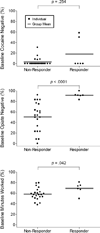Behavioral factors predicting response to employment-based reinforcement of cocaine abstinence in methadone patients
- PMID: 27777965
- PMCID: PMC5074559
- DOI: 10.1037/tps0000056
Behavioral factors predicting response to employment-based reinforcement of cocaine abstinence in methadone patients
Abstract
We sought to identify behavioral factors associated with response to an employment-based intervention, in which participants had to provide drug-free urine samples to gain access to paid employment. The present secondary analysis included data from a randomized clinical trial. The trial evaluated whether employment-based reinforcement could decrease cocaine use in community methadone patients. Participants (N=56) in the trial worked in a model workplace for 4 hr every weekday and earned about $10 per hr. After a 4-week baseline, participants were randomly assigned to an Abstinence & Work (n = 28) or Work Only (n = 28) condition and could work for an additional 26 weeks. Abstinence & Work participants had to provide cocaine-negative urine samples to work and maintain maximum pay. Work Only participants only had to work to earn pay. For Work Only participants, cocaine abstinence during baseline and the intervention period were significantly (rs = .72, p <.001) correlated. For Abstinence & Work participants, baseline opiate abstinence was significantly correlated (rs = .59, p <.001) and workplace attendance was marginally correlated (rs = .32, p = .098) with cocaine abstinence during the intervention period. Furthermore, participants who provided over 60% cocaine-negative urine samples during the intervention period (i.e., responders) had significantly higher baseline rates of opiate abstinence (p <.0001) and workplace attendance (p = .042) than non-responders. Employment-based reinforcement of cocaine abstinence may be improved by increasing opiate abstinence and workplace attendance prior to initiating the cocaine-abstinence intervention.
Keywords: Cocaine; contingency management; incentives; methadone; opiates.
Figures


Similar articles
-
Employment-based abstinence reinforcement promotes opiate and cocaine abstinence in out-of-treatment injection drug users.J Appl Behav Anal. 2014 Winter;47(4):681-93. doi: 10.1002/jaba.158. Epub 2014 Oct 8. J Appl Behav Anal. 2014. PMID: 25292399 Free PMC article. Clinical Trial.
-
The therapeutic workplace to promote treatment engagement and drug abstinence in out-of-treatment injection drug users: a randomized controlled trial.Prev Med. 2014 Nov;68:62-70. doi: 10.1016/j.ypmed.2014.02.021. Epub 2014 Mar 4. Prev Med. 2014. PMID: 24607365 Free PMC article. Clinical Trial.
-
The effects of extended-release injectable naltrexone and incentives for opiate abstinence in heroin-dependent adults in a model therapeutic workplace: A randomized trial.Drug Alcohol Depend. 2019 Apr 1;197:220-227. doi: 10.1016/j.drugalcdep.2018.12.026. Epub 2019 Feb 14. Drug Alcohol Depend. 2019. PMID: 30852374 Free PMC article. Clinical Trial.
-
Attendance rates in a workplace predict subsequent outcome of employment-based reinforcement of cocaine abstinence in methadone patients.J Appl Behav Anal. 2008 Winter;41(4):499-516. doi: 10.1901/jaba.2008.41-499. J Appl Behav Anal. 2008. PMID: 19192855 Free PMC article. Clinical Trial.
-
Behavior analysts in the war on poverty: Developing an operant antipoverty program.Exp Clin Psychopharmacol. 2018 Dec;26(6):515-524. doi: 10.1037/pha0000230. Epub 2018 Sep 27. Exp Clin Psychopharmacol. 2018. PMID: 30265062 Free PMC article. Review.
Cited by
-
Factors associated with obtaining employment among opioid use disorder patients enrolled in a therapeutic workplace intervention.Drug Alcohol Depend. 2021 Sep 1;226:108907. doi: 10.1016/j.drugalcdep.2021.108907. Epub 2021 Jul 21. Drug Alcohol Depend. 2021. PMID: 34311206 Free PMC article. Clinical Trial.
References
-
- Bandettini Di Poggio A, Fornai F, Paparelli A, Pacini M, Perugi G, Maremmani I. Comparison between Heroin and Heroin–Cocaine Polyabusers. Annuals of the New York Academy of Sciences. 2006;1074(1):438–445. - PubMed
-
- Bigelow GE, Silverman K. Theoretical and empirical foundations of contingency management treatments for drug abuse. In: Higgins ST, Silverman K, editors. Motivating behavior change among illicit-drug abusers: Research on contingency management interventions. Washington, DC, US: American Psychological Association; 1999. pp. 15–31.
-
- Black JL, Dolan MP, Penk WE, Robinowitz R, Deford HA. The effect of increased cocaine use on drug treatment. Addictive Behaviors. 1987;12:289–292. - PubMed
-
- Camacho LM, Bartholomew NG, Joe GW, Cloud MA, Simpson DD. Gender, cocaine and during-treatment HIV risk reduction among injection opioid users in methadone maintenance. Drug and Alcohol Dependence. 1996;41:1–7. - PubMed
-
- DeMaria PA, Sterling R, Weinstein SP. The effect of stimulant and sedative use on treatment outcome of patients admitted to methadone maintenance treatment. The American Journal on Addictions. 2000;9(2):145–153. - PubMed
Grants and funding
LinkOut - more resources
Full Text Sources
Other Literature Sources
